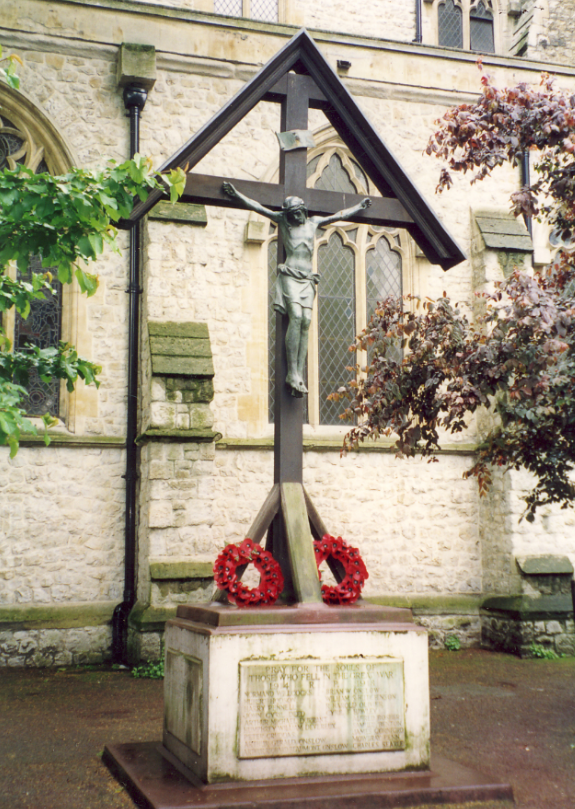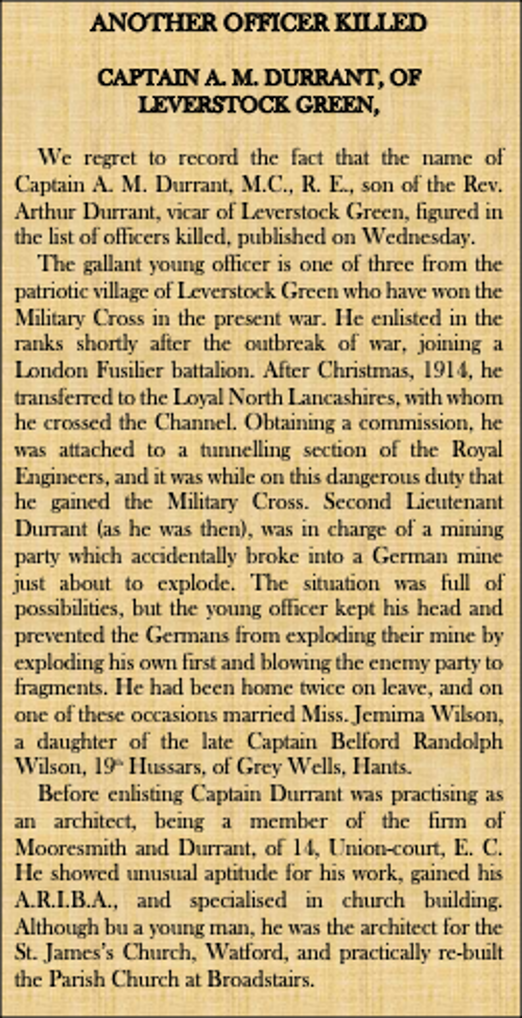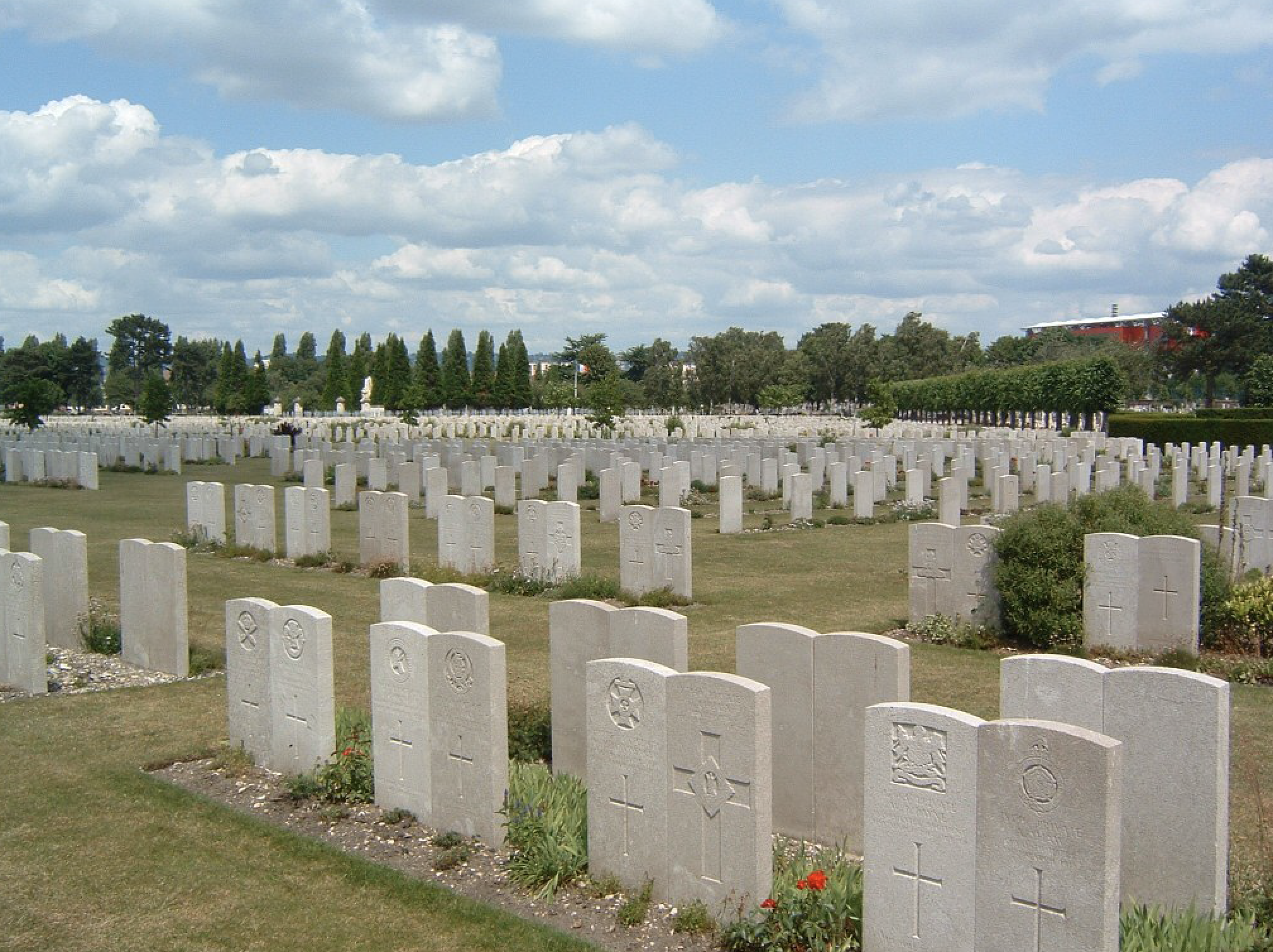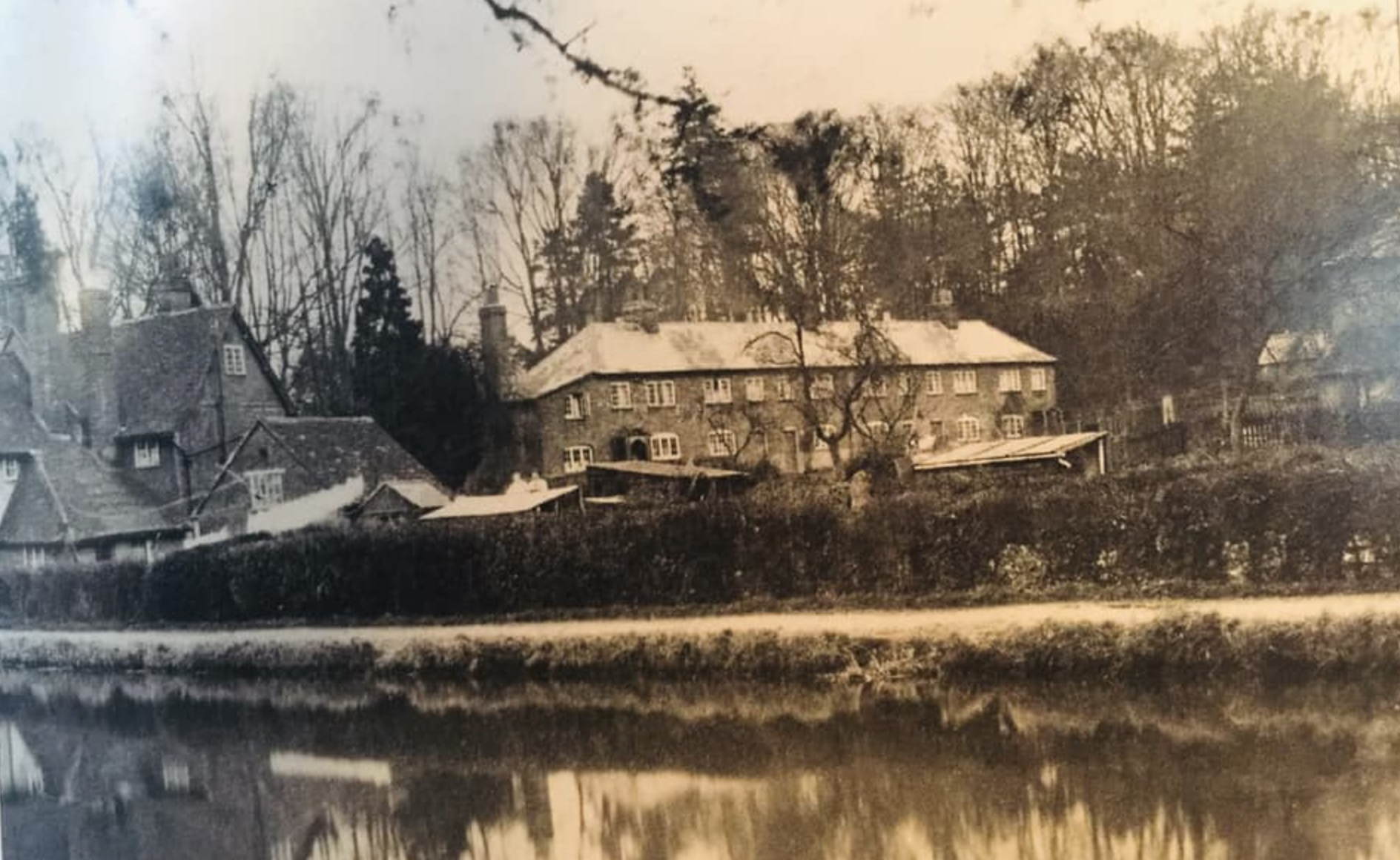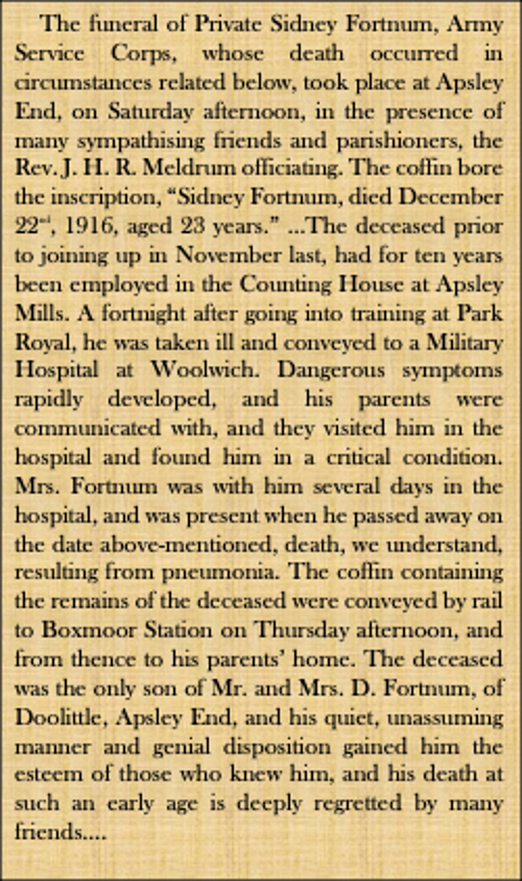Fallen in December 1916:
Robert James Bates
Arthur Michael Durrant M.C.
Arthur Nicholas Laird
Sidney Fortnum
ROBERT JAMES BATES
5143 Private
1st Bn., Hertfordshire Regiment
Died of Illness Tuesday, 5th December 1916
Remembered with Honour, Hemel Hempstead (Heath Lane) Cemetery, United Kigdom
Robert
James Bates was born on Saturday, 13th October 1894 in Boxmoor near
Hemel Hempstead, to Frederick William Bates and Emily Hollick. He was the
seventh child and fifth son born to Frederick and Emily who would eventually
have thirteen children, four of whom died in infancy. Frederick and Emily
raised their large family at 55 St John’s Road in Boxmoor, where they had lived
since their marriage in 1880 and where they would remain until they died
sixty-four years later.
Throughout
this time Frederick and many of his sons, including Robert, worked at Fosters
Limited, the local sawmills on Kingsland Road adjacent to the Grand Junction
(Union) Canal.
Robert’s education took place at Boxmoor JMI School where in 1902/3 he successfully completed Standards I and II eventually leaving on the 11th October 1907 to start work as an Errand Boy in Apsley Paper Mills. By the time he enlisted in the Army he was working at Fosters Saw Mills as a Mill Hand.
On the 7th June 1915 Robert aged twenty, enlisted with the Hertfordshire Regiment attesting at Hertford on that date. He was described as having black hair and hazel eyes and standing 5 feet 7 inches in height, taller than the average recruit at the time.
Robert spent the next eight months training with the 3/1st Battalion before being sent to France on the 13th March 1916. Crossing from Southampton he disembarked at Rouen the following day before joining the 1st Battalion Hertfordshires near Merville, north of Béthune on the 27th March.
Through April, Robert was in the trenches at Merville and Festubert before marching with the Battalion to Givenchy to take over the B2 sub-section of the trenches. It was here on the 19th May that Robert first fell ill and the following day he was admitted to No.132 Field Ambulance diagnosed with pleurisy. Two days later he was admitted to No.9 General Hospital in Rouen for further treatment. By the 30th May 1916 he had been transferred back to England having been at the Front only fifty-four days.
Respiratory illnesses such as pleurisy were rife in the trenches and the medical support and treatment was primitive in the field. If a wounded or injured soldier made it to a Base Hospital, such as No.9 General at Rouen, their chances of recovery increased significantly. However, with illness and disease the medical interventions and treatment of the time were often limited, and this was before the discovery of anti-biotics. It is estimated that approximately ⅓ of all combatants died of illness or disease.
On his return to England, Robert underwent further medical treatment which seemed to help his recovery from pleurisy. However, Army medical notes indicate that he showed signs of early ‘plastic tubercular peritonitis’ a much more serious condition and it was this that ultimately caused his discharge from the Army on the grounds that he was ‘unfit for army service’. It is also noted that his disability was due to “Natural causes aggravated by exposure on active service” meaning that his active service was not the cause but only a contributing factor.
The medical
reports also note that his condition was not permanent although it would restrict
his ability to work for about six months and possibly longer. Finally, and
perhaps most tragically, the reports state that Robert’s recovery depended on “proper treatment which he states he can
carry out at home”. Quite what this treatment was and how Robert would
manage it is not clear. Indeed, within three months of his discharge from the
Army on the 26th September 1916, Robert died. He passed away in West
Herts Infirmary, Hemel Hempstead on Tuesday, 5th December 1916 and
was buried in Heath Lane Cemetery on Saturday, 9th December 1916.
Robert is Remembered with Honour in the Hemel Hempstead (Heath Lane) Cemetery, Hemel Hempstead United Kingdom.
He was only 22 years old when he died.
Robert was eligible for the British War Medal and the Allied Victory Medal.
The Bates Family in 1911 living at 55 St. John's, Road in Boxmoor (Image: Traquair Publishing 2016)
Fosters Saw Mills where many of the Bates men worked (Photo: https://www.hertsmemories.org.uk/)
55 St. John's Road, Boxmoor today (Photo: Traquair Photography 2016)
War Memorial Plaque, St Mary and St Joseph Church, Boxmoor (Photo: Traquair Photography)
Footnote: When I began to research the men commemorated on Hemel Hempstead War Memorial, I was contacted by Brendan Sheridan, who had carried out similar research on the men from the congregation of St Mary and St Joseph Roman Catholic Church, Boxmoor. Brendan kindly agreed to share his research for inclusion on this website and also brought to my attention the fact, that Private Robert James Bates had not been recognised as a victim of the Great War and therefore, had not been officially recorded by the Commonwealth War Graves Commission (CWGC). We both agreed that this was something to be put right and during research, I uncovered the evidence we needed to confirm, that despite dying after being discharged from the Army, Robert's records showed that the Army Medical Board considered his death was as a result of active service. This information was sent to the "In From the Cold Project" (IFCP) which is dedicated to the task of achieving recognition for the thousands of men and women who died in the service of Britain and the Commonwealth during two world wars where there is no official recognition of their sacrifice. I am happy to say, that on the 5th November 2019, IFCP confirmed to Brendan and me, that CWGC had accepted our information and that Robert's grave in Heath Lane Cemetery would in due course have a headstone erected to honour his sacrifice in the Great War.
I should add, that Brendan was also instrumental in ensuring that a memorial plaque to all the fallen heroes from St Mary and St Joseph, was commissioned and erected at the Church. I was honoured to attend the dedication and unveiling of the memorial on Remembrance Sunday, 11th November 2018, the centenary of the Armistice marking the end of the Great War.
ARTHUR MICHAEL DURRANT M.C.
Captain
257th Tunnelling Coy., Royal Engineers
Killed in Action Tuesday, 5th December 1916
Remembered with Honour, Pont-Du-Hem Military Cemetery, La Gorgue, Nord, France, Grave II.C.11.
Arthur Michael Durrant, known as Michael, was born on Sunday, 29th September 1889 in West Ham London, the second child to parents Arthur Durrant and Alice Mabel Pelly. Arthur and Alice had four children in all; Lorna Milicent, Arthur Michael, Enid Mary and Dorothy Mary. Michael’s mother Alice was a great-grand-daughter of the prison reformer Elizabeth Fry and his father Arthur was a clergyman in the Church of England.
Sadly, for Arthur Snr., he outlived his wife, son and two youngest daughters. Michael’s youngest sister, the adventuress Lady Dorothy May Clayton East Clayton, died tragically in 1933 at the age of twenty-seven in a flying accident and she is generally thought to be the model for the character Katherine Clifton, in the book and film “The English Patient”.
Michael’s father was installed as the Vicar of Holy Trinity Church in Leverstock Green, Hertfordshire in 1899 where he remained until his death thirty-six years later.
In 1901, twelve-year-old Michael was a boarder at Malvern College in Worcestershire, where he was a talented young artist leading him to study as an architect. He entered the firm of Moresmith & Durrant, Architects in the City of London where he trained, and soon specialised in church design and building. He designed St James’ Church in Watford Fields when he was only nineteen and was responsible for the refurbishment of Holy Trinity Church in Broadstairs, Kent in 1914.
Between 1910 and 1913 Michael served with the Sussex Yeomanry so on the outbreak of war, he immediately enlisted, attesting on the 29th August 1914 when he joined the Royal Fusiliers as a Private and was posted to the 10th Battalion. He later applied for a commission, which was confirmed on the 30th November and he was then posted to the 8th Battalion Loyal North Lancashire Regiment and sent to France.
Michael disembarked at Boulogne on the 4th December 1914 and shortly afterwards was attached to 171st Tunnelling Company Royal Engineers near Ploegsteert in Flanders. A year after his arrival on 23rd December 1915, he was the officer in charge of a mining party when an enemy tunnel and listening post was accidentally broken into and then destroyed.
An account of the incident was published in the London Gazette with the announcement of the award of the Military Cross for Michael's brave actions: "For conspicuous gallantry and resource near Frelinghein on 23rd December 1915. When a charge placed by our miners in a German gallery had only partially exploded and warned the enemy; Second Lieutenant Durrant, with two other officers, succeeded in placing a second charge which demolished the enemy's gallery. There was imminent danger throughout of the Germans exploding a mine. For several months Second Lieutenant Durrant has been carrying out dangerous work in almost constant contact with the enemy, and has set a fine example of coolness and determination." He was mentioned in dispatches by General Sir Douglas Haig.
On 2nd February 1916 Michael was officially transferred to the Royal Engineers and a month later was temporarily attached to the Controller of Mines for the 3rd Army. He was granted home leave and returned to London where he married his fiancée, Jemima Wilson at the church of St. George in Hanover Square. Jemima was from a wealthy society family descended from Edward Lascelles, 1st Earl of Harewood, whose huge fortune had derived in part from the slave trade. Following their wedding Michael returned to the Front and was never to see his wife again.
On 1st July 1916 he was promoted to the rank of Acting Captain, commanding a section of a Tunnelling Company and next day joined the newly arrived 257th Tunnelling Company attached to the 3rd Australian Tunnelling Company.
Towards the end of the year the 257th was no longer tunnelling but instead deployed as a fighting unit and in early December, just north of ‘Winchester Crater’, Michael was killed in action during an enemy bombardment.
Michael died on Tuesday, 5th December 1916.
Jemima remarried in 1923.
His sad demise was reported in the Hemel Gazette shortly afterwards. (see extract)
He was commemorated on a memorial at St Saviour’s Church in Pimlico, London close to where he had worked. Michael was also remembered on the Leverstock Green War memorial.
Michael is Remembered with Honour in Pont-Du-Hem Military Cemetery, La Gorgue, Nord, France where he is interred in Grave II.C.11.
He was 27 years old when he died.
Michael was entitled to the 1914–15 Star, the British War Medal and the Allied Victory Medal.
St. Saviours Church War Memorial, Pimlico, London (Courtesy: Traquair Photography 17th November 2016)
Capt. Arthur Michael Durrant M.C. c1915 (Courtesy: IWM - Bond of Sacrifice, First World War Portraits Collection)
St James’ Church, Watford Fields – designed by Michael Durrant (Courtesy: Traquair Photography 14th January 2015)
The Military Cross (Public Domain)
Extract from The Hertfordshire, Hemel Hempstead Gazette and West Herts Advertiser 16th Dec. 1916
Pont-Du-Hem Military Cemetery, La Gorgue, Nord, France (Courtesy: CWGC)
ARTHUR NICHOLAS LAIRD
34240 Private
143rd Coy., Machine Gun Corps (Infantry)
Died of Wounds Monday, 11th December 1916
Remembered with Honour, St. Sever Cemetery Extension, Rouen, Seine-Maritime, France Grave O. III. R. 8.
Arthur Nicolas Laird was born in Poplar, London on Wednesday, 8th September 1897 the younger of two sons born to Arthur William Laird and Sarah Louisa Slade. His older brother by two years was Edward Charles, who also saw service in the Great War with the 23rd Battalion Middlesex regiment and survived the conflict.
When Arthur was born his family lived at 45 Benledi Street in Poplar, a short distance from East India Docks where his father Arthur Snr. worked as a ‘Shipping Clerk’. By 1911 the family had moved around the corner to 3 Blair Street and thirteen-year-old Arthur was at school, whilst his brother Edward had started work as an ‘Assistant in a Fruit Salesroom’.
After leaving school in 1911 Arthur, like his father, worked as a ‘Shipping Clerk’ and three years later on the outbreak of war, he joined the Colours. He enlisted on the 10th November 1914 attesting in London and joining the 3/14th (Reserve) Battalion London Regiment (London Scottish). Despite being underage and ineligible to join the forces, Arthur was nevertheless accepted as a recruit aged seventeen years and three months.
His service records show that he was taller than average at 5ft 7½ins and weighed 9st 5lbs with a chest measurement of thirty-five inches and a range of expansion of four inches. His physical development is described as "Very Good", so perhaps it is no surprise that he was accepted as an underage soldier.
He served on home defence duties with the London Scottish and shortly after he was embodied, he was sent to Abbots Langley in Hertfordshire with the battalion where he undertook his basic training.
By the end of 1915 the London Scottish were on active service based out of Richmond Park Camp in West London and in September and again in November, Arthur was punished for lapses of conduct. Firstly, he was "absent without leave" for several hours whilst on "active service" for which he received extra guard duties. Secondly, a more serious offence; "Whilst on active service failing to comply with an order" which resulted in "7 days CB" (confined to barracks).
In May 1916 he was discharged from the London Scottish so that he could re-enlist for overseas service. He attested at Westminster joining the Machine Gun Corps and was posted to the 143rd Company which was under the orders of the 48th (South Midlands) Division in the 143rd Warwickshire Brigade. Just two months later and shortly before his nineteenth birthday Arthur went to France.
He left from Folkestone and disembarked in Boulogne on the 25th July 1916 and joined his Battalion six days later at Coulonvillers about seven miles east of Abbeville. Arthur was soon in action and fought in the latter stages of the Battle of Pozières and then in November in the Battle of Ancre.
On the 24th November the 143rd Company was part of the relief of the 1/4th Gloucesters in the front-line trenches and during the transfer three men were wounded, of which Arthur was one. He was admitted with gun shot wounds, first to a Casualty Clearing Station before being sent to No.9 General Hospital at Rouen five days later on the 30th November.
Arthur was treated in hospital for the next twelve days, but to no avail and he succumbed to his wounds on Monday, 11th December 1916.
It appears that Arthur never lived in Hemel Hempstead, although he may well have visited when undergoing basic training at Abbot's Langley. His presence on the town war memorial is due to his mother Sarah and his brother Edward who were known to be in the town between 1918 and 1921. It seems that Edward, a fruit buyer and salesman was living and working in Hemel immediately after the war and was certainly resident in the town from 1921 onwards. He and his wife Rose were joined by his mother following his father's death in early 1921 and by 1939 they lived together at 1 Glendale Road where Sarah died in 1951.
Arthur is Remembered with Honour in St. Sever Cemetery Extension, Rouen, Seine-Maritime, France where he is interred in Grave O. III. R. 8. The inscription on his headstone, requested by his mother Sarah Louisa, simply reads: “RESTING”.
He was only 19 years old when he died.
Arthur was entitled to the British War Medal and the Allied Victory Medal.
East India Docks where Arthur had worked before the war (Public Domain)
The Vickers Machine Gun which Arthur would have been trained to use (Public Domain)
No.9 General Hospital Rouen, France (Public Domain)
St. Sever Cemetery Extension, Rouen, Seine-Maritime, France (Photo: CWGC)
SIDNEY FORTNUM
T/277534 Driver
662nd Heavy Transport Coy., Army Service Corps
Died of Illness Friday, 22nd December 1916
Remembered with Honour, Apsley End (St. Mary) Churchyard, Apsley, Hertfordshire, United Kingdom
Sidney Fortnum, known as Sid, was born in Abbotts Langley on Saturday, 18th February 1893 and baptised at St John the Baptist church in Aldbury, Hertfordshire when he was nine years old on Sunday, 2nd November 1902. He was the only surviving son born to Dan Fortnum and Mary Wilson Sangster, who had lost their first-born son Dan when he was only an infant in 1890.
Sid’s father worked as a ‘Paper Cutter’ at John Dickinson & Co Limited in Apsley Mills, a job he would do until his retirement. Dan was a native of Hemel Hempstead and he met and married his wife Mary after she had come south from Dyce near Aberdeen where she had been born. Mary had worked as a ‘Paper Folder’ in a paper mill in Auchmull, south of Aberdeen and she moved to Apsley End to work for Dickinsons in the early 1880s.
Sid lived with his mother and father at 1 Doolittle in Apsley End, not far from the paper mills, in the house the Fortnum’s lived in well into the 1920’s.
When he left school in 1906, Sid started work with Dickinsons at Apsley Mills and was employed as a Clerk in the ‘Counting House’ where he worked for the next ten years until he joined up. On the 1st November 1915 he enlisted in the Royal Flying Corps, but his service was cut short after only four days and he was discharged. This was not unusual, as in the early years of the war approximately 45% of recruits were rejected and deemed to be unsuitable to fly for many reasons.
He enlisted in the Army a year later in November 1916 when he joined the Royal Army Service Corps and was posted to the 662nd Heavy Transport Company. He went to Park Royal in west London to train, but only two weeks after arriving he fell ill and was quickly admitted to the Royal Herbert military hospital on Shooter’s Hill, Woolwich in London. Sid’s condition worsened quickly and his parents were informed that he was ill and visited to find him in a critical condition.
His mother stayed with him as he deteriorated and she was with him when he died, just three days before Christmas, on Friday, 22nd December 1916. The cause of Sid’s death was pneumonia.
Sid was brought home to Apsley by train and his coffin taken to his parent’s house on Thursday, 28th December 1916 and two days later his funeral service was held at St Mary’s Church in Apsley. Officiating at the service on Saturday, 30th December, was the Reverend James Herbert Lendrum, who would also fall in the Great War in August 1918. The Reverend Lendrum’s biography also appears on this site.
Sid’s funeral was well attended by family, friends and work colleagues who all knew him for his “quiet, unassuming manner and genial disposition”. He was laid to rest in the churchyard of St Mary’s, Apsley.
Sid was the last of the local men to die in 1916 whose name is recorded on the Hemel Hempstead War Memorial.
A detailed report describing the service appeared in the Hemel Gazette on the Saturday following his burial. (see extract)
He is commemorated on the memorial plaque in St Mary’s church and on the John Dickinson & Co War Memorial in Apsley.
Sid is Remembered with Honour in Apsley End (St. Mary) Churchyard, Apsley, Hertfordshire, United Kingdom where he is interred in a Grave against the north hedge.
He was 23 years old when he died.
Sid was entitled to the British War Medal and the Allied Victory Medal.
Doolittle where Sid was born and grew up (Courtesy: Hemel Hempstead (Archive Photographs), Eve Davis, 1997)
The Royal Herbert Military Hospital, Woolwich where Sid died (Courtesy:http://www.royalherbert.co.uk/)
Extract from The Hertfordshire, Hemel Hempstead Gazette and West Herts Advertiser 6th Jan. 1917
John Dickinson & Co War Memorial, Apsley (Courtesy: Traquair Photography 28th Aug. 2016)
Headstone of Sidney Fortnum, St. Mary's Churchyard, Apsley, Hertfordshire, United Kingdom (Courtesy: Traquair Photography 28th Apr. 2018)
